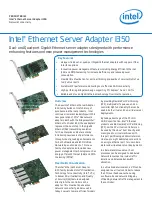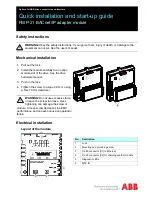
Intel® Ethernet Server Adapter I350
Dual- and Quad-port Gigabit Ethernet server adapters designed with performance
enhancing features and new power management technologies
Overview
The new Intel® Ethernet Server Adapter
I350 family builds on Intel’s history of
excellence in Ethernet products. Intel
continues its market leadership with this
new generation of PCIe* GbE network
adapters. Built with the bridgeless Intel®
Ethernet Controller I350, these adapters
represent the next step in the Gigabit
Ethernet (GbE) networking evolution
for the enterprise and data center by
introducing new levels of performance
through industry-leading enhancements
for both virtualized and iSCSI Unified
Networking environments. This new
family of adapters also includes new
power management technologies such as
Energy Efficient Ethernet (EEE) and DMA
Coalescing (DMAC).
Flexible I/O Virtualization
The Intel® Ethernet Server Adapter
I350 family includes Intel® Virtualization
Technology for connectivity (Intel® VT-c)
to deliver I/O virtualization and Quality
of Service (QoS) features designed
directly into the controller on the
adapter. I/O virtualization advances
network connectivity models used in
today’s servers to more efficient models
by providing Flexible Port Partitioning
(FPP), multiple Rx/Tx queues, and on-
controller QoS functionality that can be
used in both virtual and non-virtual server
deployments.
By taking advantage of the PCI-SIG
SR-IOV specification, Intel® Ethernet
products enable Flexible Port Partitioning
(FPP). With FPP, virtual controllers can
be used by the Linux* host directly and/
or assigned to virtual machines. With
this port partitioning, administrators can
create up to eight dedicated connections
on a single Ethernet port for use in bare-
metal and virtualized server deployments.
In a bare-metal Linux server, host
processes can be assigned to dedicated
network resources to provide traffic
isolation and balanced bandwidth
allocation.
In a virtualized environment, a VM can be
assigned to a virtual controller to reduce
the CPU overhead seen when using
a software-based network bridge by
offloading network traffic management to
the controller.
Key Features
•
Halogen-free dual- or quad-port Gigabit Ethernet adapters with copper or fiber
interface options
•
Innovative power management features including Energy Efficient Ethernet
(EEE) and DMA Coalescing for increased efficiency and reduced power
consumption
•
Flexible I/O virtualization for port partitioning and quality of service (QoS) of up
to 32 virtual ports
•
Scalable iSCSI performance delivering cost-effective SAN connectivity
•
High-performing bridgeless design supporting PCI Express* Gen 2.1 5GT/s
• Reliable and proven Gigabit Ethernet technology from Intel Corporation
PRODUCT BRIEF
Intel® Ethernet Server Adapter I350
Network Connectivity

























